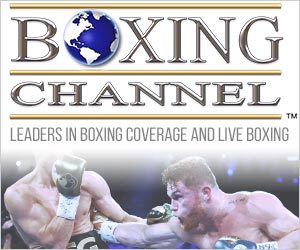Featured Articles
Foreman Fondly Remembers “Geezers At Caesars”

His is the most distinct dual-era career in boxing history. There was the rise of George Foreman (Part I), in which a remorseless young destroyer from Marshall, Texas, pulverized opponents without ever seeming to crack a smile. That was followed by the rise of George Foreman (Part II), a physically and spiritually transformed individual who emerged from a 10-year retirement fat and happy, but with the same gift for bludgeoning the guy in the other corner into submission.
Now, at 67 (as of Jan. 10), Foreman has the luxury of sitting back and taking stock of both phases of his remarkable boxing journey, and even that portion which preceded Part I of his professional life. Upon reflection, he sees much that is good along the way, a journey of self-discovery from which he has culled four bouts he now considers to be his personal favorites.
No, the “Rumble in the Jungle” against Muhammad Ali is not included; Big George lost that one, in a monumental upset, and few fighters are apt to list a defeat among their most cherished memories. The first touchstone event for Foreman is his gold-medal run through the 1968 Mexico City Olympics, capped by his emphatic, second-round stoppage of the Soviet Union’s Jonas Cepulis. A lot of people will forever remember the image of Foreman, his surliness temporarily put aside, parading around the ring while waving a tiny American flag.
Favorite Fight No. 2 is his two-round demolition of WBC/WBA heavyweight champion Joe Frazier in Kingston, Jamaica, on Jan. 22, 1973, in which the 6-foot-3 Foreman – then a lean and taut 217½ pounds – knocked down the favored Smokin’ Joe six times, the last coming on a right uppercut that lifted the previously undefeated and indomitable conqueror of Ali into the air like a Cape Canaveral rocket during blastoff.
“I didn’t think I belonged there,” Foreman said, citing the stumpy left hooker from Philadelphia as the only man who ever elicited fear in him. “I was fighting Joe Frazier! Every time he threw a hook that missed, it was like a bullet whizzing by my head. I’m not ashamed to say I was afraid of him.”
But didn’t that sense of impending doom subside or even vanish once Frazier started going down?
“I never got to that point because he kept getting up,” Foreman explained. “I’m thinking, `Man, if this thing goes to the fourth round, I could be in trouble.’ I never did feel like I had it for sure. Not in that fight, not against the great Smokin’ Joe.”
Favorite Fight No. 3 came on Jan. 24, 1976, in Foreman’s first bout after being upset by Ali, a loss that severely shook the defrocked champion’s confidence in himself. His opponent that night at Las Vegas’ Caesars Palace, for the vacant NABF title, was another huge puncher, Ron Lyle, who figured he could do unto Big George what Ali had done. And Lyle seemingly was in the process of doing just that, flooring Foreman twice in what eventually was named The Ring’s Fight of the Year. Twice Foreman crumpled to the canvas and, after the second flooring, in a semi-stupor, he had an epiphany.
“When he knocked me down I was, like, `Wow, it wasn’t a fluke (getting knocked out by Ali) in Africa,’” Foreman said. “I told myself, `You got to get up, you got to get up.’ I got up, then he put me down a second time. That’s when I asked myself, `Are you a fighter or are you going to quit?’ If I hadn’t gotten up then, nobody would have ever believed in me again. I wouldn’t have believed in me.That would have been my exit from boxing, forever.”
Favorite Fight No. 4 was … ah, here’s where the surprise comes in. It’s not what most people would expect, Foreman’s one-punch knockout of WBA/IBF champ Michael Moorer, who was well ahead on points, in the 10th round of their Nov. 5, 1994 bout at the MGM Grand in Las Vegas when Foreman landed the straight right heard ’round the world. “It happened! It happened!” HBO blow-by-blow announcer Jim Lampley excitedly repeated as Foreman ascended to a second championship reign 20 years after the first one ended.
But, to Foreman’s way of thinking, the bolt-from-the-blue conquest of Moorer was merely the culmination of a process that had played out in his mind even before he began his long-delayed comeback. On March 9, 1987, against journeyman Steve Zouski in Sacramento, Calif., the then-38-year-old Foreman, who had eaten his way up to 320-plus pounds and had pared down only to a distinctly unsvelte 267 pounds, put away journeyman Steve Zouski in five rounds.
As grand plans go, it was hardly an auspicious launch. But then it was just what Foreman had in mind. He was on a mission, but not one on an accelerated timetable. Like the tortoise that Aesop’s fable, Big George understood that the race does not necessarily go to the swift. Sometimes slow and steady is preferable to fast and furious.
“Not everyone can plot and plan like I did. They don’t have the patience,” Foreman said of a return to the ring that, at first, drew mostly snickers and derision. “I deliberately took time. I stayed off television. I wanted to lay low until I developed my skills.”
And so it went, Foreman winning 19 fights in as many outings against mostly has-beens and never-weres, beating 18 of them inside the distance. But eventually the moment came when he had to put up or shut up, and that night arrived on Jan. 15, 1990.
George Foreman vs. Gerry Cooney. The matchup of presumably past-their-prime sluggers (Cooney, 33, had not fought since his fifth-round technical knockout loss to Michael Spinks on June 15, 1987) officially was labeled “The Preacher and the Puncher,” the preacher, of course, being Foreman. But UPI boxing writer Dave Raffo had dubbed it “The Geezers at Caesars,” which the public quickly latched onto, and never mind that the scheduled 10-rounder actually would take place in Boardwalk Hall and not neighboring Caesars Atlantic City, which was sponsoring the event.
Although some dismissed the matchup as something akin to the circus coming to town – one Philadelphia reporter (that would be me) wrote that “America is and has always been a society of the curious, voyeuristic and gullible, which is why those modern Barnums, boxing promoters, continue to run freak shows up the flagpole to see just how many of us will salute” – both combatants understood it to very much be the real deal. Speculation already was rampant that the winner would move on to a megabucks matchup with heavyweight champion Mike Tyson.
“That fight turned everything around,” Foreman said of the second-round knockout that legitimized what, until then, had seemed an impossible dream. “If Cooney had won that fight, even on points, that would have derailed me. That was the one fight that did it. Not only did I win, but the fashion that I did it determined my destiny.”
Because he had been active, even if not against top-tier opponents, Foreman opened as a 3-to-1 favorite, which was whittled down to 9-to-5 by the opening bell when word began spreading that Cooney, whose pulverizing left hook was his weapon of choice, was looking very sharp in training under the watchfui eye of new trainer Gil Clancy, who had helped bring out the best in such notable fighters as Emile Griffith, Ken Buchanan and Jerry Quarry. There was a rising sentiment that if Cooney, who had whacked out Ken Norton in one round, Lyle in one round and Foreman conqueror Jimmy Young in four, connected with one of his trademark hooks, George and the 253¼ pounds he was packing (36¼ more than he weighed the night he walloped Frazier) would come crashing down like an imploded building.
“When you talk about left hooks, I think Cooney – when he was really at his best – had one that would match up with anybody’s in terms of power,” said Larry Hazzard, the boss of the New Jersey State Athletic Control Board. “That was his punch. I imagine it still is.”
But Hazzard’s optimistic view that Foreman-Cooney was a potential clash of the titans wasn’t shared by all. Ferdie Pacheco, the NBC boxing analyst (the fight was televised via closed-circuit and pay-per-view) and former personal physician to Muhammad Ali, said that Cooney, who, depressed, had begun to drink heavily after his loss to Spinks, “has the face of a drunk trying to make a comeback” while deriding Foreman as “grossly overweight and flabby.” Trainer Tommy Gallagher, who was the chief second for WBO middleweight champion Doug DeWitt, who would yield his title to Matthew Hilton on an 11th-round stoppage on the Foreman-Cooney undercard, said the main event was “a joke, in my opinion. But I guess I can see where some people might find it interesting.”
For his part, Foreman didn’t mind the verbal jabs aimed at him about his weight. He had come in at a relatively trim 235 pounds for his March 19, 1988, bout with Tyson-sized Dwight Muhammad Qawi and, although George won via seventh-round TKO, he felt like his legendary strength had been substantially drained.
“When I fought Qawi, my body was almost like it was in the ’70s,” Foreman said. “I had concentrated so much on losing all that weight that I lost track on who I needed to be the second time around. I didn’t make that mistake again. From then on, I was always at or over 250.
“I knew what Cooney could do. He knocked out Norton. He knocked out Lyle. He was just going down the line of my generation, mowing us down one by one. I knew he had to be thinking, `OK, Foreman’s next.’
“But you know what frightened me more than anything? It was that Cooney had hired Gil Clancy to work his corner. Gil was a good boxing man who knew how to get a fighter ready to fight his best fight.”
Clany’s prefight strategy was sound enough. The 6-7 Cooney would box the old, fat guy, take him into the middle rounds where his perceived lack of stamina would come into play, and try to stay out of Foreman’s optimal punching radius until he saw openings to move in and connect with that big left hook. The plan might have worked, too, except that such an opening came too early.
When Cooney landed that big hook in the first round, Clancy instinctively knew that his guy had seized an advantage that needed to be capitalized on right then, when Foreman was still buzzed. But, curiously, Cooney hesitated.
“He didn’t believe it (that Foreman was in trouble),” Clancy said afterward. “Inactivity does that.”
For his part, Clancy changed course and advised Cooney to go right after Foreman in Round 2. It proved to be a disastrous miscalculation.
“After the first round Cooney went back to his corner and Clancy said, `You got him! You got him!’” Foreman recalled. “I was like, `Dang, I didn’t think anybody knew that but me.’ And he did come right after me. I had a fight on my hands. I knew I had to get him before he got me.”
Foreman did exactly what he needed to do, He wobbled Cooney with a left hook of his own, which was followed by a succession of clubbing right hands that put “Gentleman Gerry” in deep trouble and drew a mandatory eight-count that would not be nearly a long-enough reprieve. Referee Joe Cortez didn’t even bother with a count when Foreman followed up with a left uppercut and overhand right; Cooney was unconscious even before he landed on the canvas, face-first.
When he was revived, Cooney said that Foreman “hit me harder than anyone I’ve ever been in the ring with.” Foreman graciously allowed that Cooney was “the hardest left-hook puncher I faced. His hook was harder than Joe Frazier’s.”
One can only imagine what might have happened had not Tyson lost his championship to Buster Douglas three weeks later in Tokyo. The Tyson-Foreman megafight that seemingly had been put into place by George’s KO of Cooney never took place.
“Tyson truly was a tiger,” Foreman said. “But it wasn’t like I was begging to fight him. He was a short guy and, because I would be jabbing downward, I thought I’d have had a good chance of beating him. Then again, he’d been taught how to do well when he fought taller guys, so it would have been interesting. I had Tyson in mind when I boxed Qawi. But when Tyson lost to Douglas, that basically was the end of that.”
Even missing out on a shot at Tyson, however, couldn’t dull the high Foreman experienced from beating Cooney. It was a fight he needed to win to not only maintain relevance, but to build on it.
“It was a big night. A big night,” Foreman said, savoring the memory. “And everybody knew it. It was in the air. Before the fight, people knew something momentous was going to happen, one way or the other. Fortunately, things went my way.
“Walking out of that arena in Atlantic City that night … I’ll never forget it. I wasn’t on top just yet, but I felt like I was back on top.”
Cooney never fought again, but unlike the funk he fell into following his losses to Larry Holmes and Spinks, he made peace with himself. He now co-hosts a boxing program with Randy Gordon on Sirius XM, on which Foreman has been a guest several times.
“Gerry and I are great friends now,” Foreman said. “Boxing is funny that way, isn’t it? I was even friendly with him when we fought. Gerry Cooney is a very encouraging-type person. He inspires people. There are times when he’s inspired me as well.”
-30-
-

 Featured Articles4 weeks ago
Featured Articles4 weeks agoAvila Perspective, Chap. 330: Matchroom in New York plus the Latest on Canelo-Crawford
-
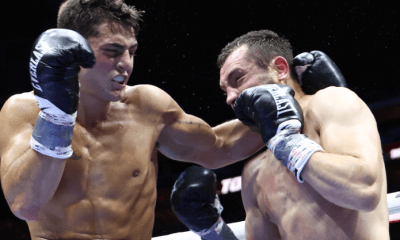
 Featured Articles3 weeks ago
Featured Articles3 weeks agoVito Mielnicki Jr Whitewashes Kamil Gardzielik Before the Home Folks in Newark
-
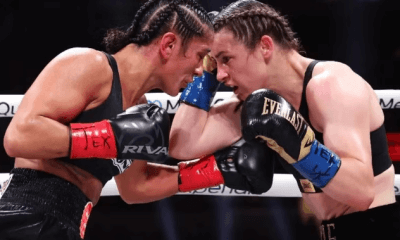
 Featured Articles17 hours ago
Featured Articles17 hours agoResults and Recaps from New York Where Taylor Edged Serrano Once Again
-
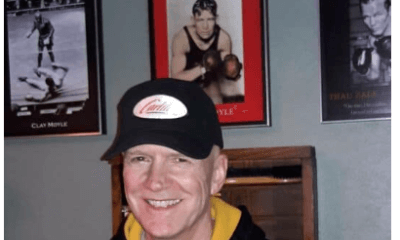
 Featured Articles4 weeks ago
Featured Articles4 weeks agoCatching Up with Clay Moyle Who Talks About His Massive Collection of Boxing Books
-

 Featured Articles5 days ago
Featured Articles5 days agoFrom a Sympathetic Figure to a Pariah: The Travails of Julio Cesar Chavez Jr
-
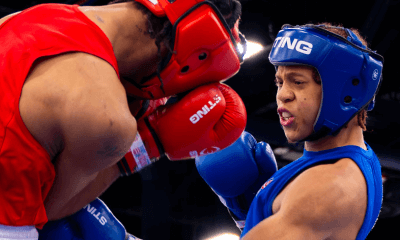
 Featured Articles3 weeks ago
Featured Articles3 weeks agoMore Medals for Hawaii’s Patricio Family at the USA Boxing Summer Festival
-
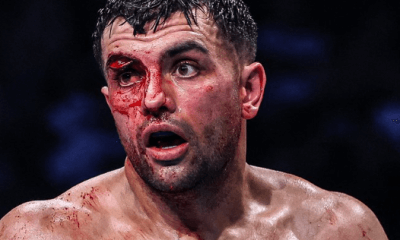
 Featured Articles7 days ago
Featured Articles7 days agoCatterall vs Eubank Ends Prematurely; Catterall Wins a Technical Decision
-
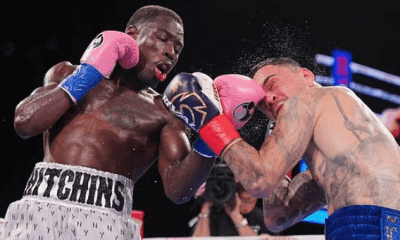
 Featured Articles4 weeks ago
Featured Articles4 weeks agoRichardson Hitchins Batters and Stops George Kambosos at Madison Square Garden

















